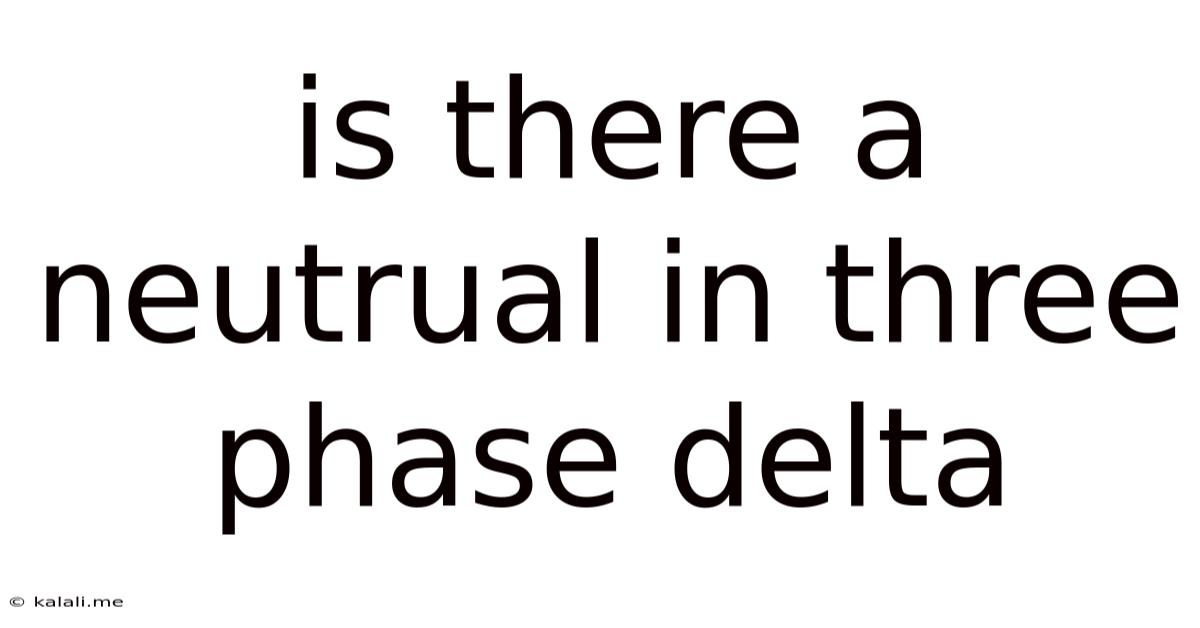Is There A Neutrual In Three Phase Delta
Kalali
Jun 10, 2025 · 3 min read

Table of Contents
Is There a Neutral in a Three-Phase Delta System? The Short Answer and Why It Matters
Meta Description: Understanding three-phase power systems is crucial for electricians and engineers. This article clarifies the presence (or lack thereof) of a neutral point in delta configurations, explaining the implications for grounding and system design.
Three-phase power is the workhorse of industrial and commercial electricity, providing efficient and reliable power delivery. A key difference between two common three-phase configurations – wye (star) and delta – lies in the presence (or absence) of a neutral point. This article tackles the question: is there a neutral in a three-phase delta system? The short answer is no, not directly. Let's delve into the reasons why and explore the consequences.
Understanding Delta Connections
In a delta system, the three windings of the transformer or generator are connected end-to-end, forming a closed triangle (hence the name "delta"). Each phase voltage is applied directly across one winding. Unlike a wye connection, there's no common point connecting the beginnings of all three windings. This fundamental difference has significant implications for grounding and the availability of a neutral point.
Why No Neutral?
The absence of a neutral point stems from the delta connection's inherent topology. The voltage between any two phases (line-to-line voltage) is the same as the voltage across each individual winding (phase voltage). Because the windings form a closed loop, there's no central point to serve as a neutral reference.
Implications of the Lack of a Neutral
The absence of a neutral wire has several consequences:
- No direct path for zero-sequence currents: Unbalanced loads or faults in a delta system cannot easily return to the source through a neutral path. These unbalanced currents circulate within the delta configuration, potentially leading to increased stress on the windings and causing overheating.
- Grounding considerations: Grounding in delta systems is crucial for safety and to handle fault currents. This is often achieved through grounding one point of the delta configuration or using a separate grounding system. The method employed heavily depends on the specific application and safety regulations.
- Difficulty in obtaining single-phase power: Unlike wye systems, obtaining a single-phase supply directly from a delta system is more complex and usually involves using a transformer.
- Higher line-to-line voltage: The line-to-line voltage in a delta system is higher than the phase voltage, which can be advantageous in certain applications requiring higher voltage levels.
Is there ever a pseudo neutral?
While there isn't a true neutral point within the delta configuration itself, some systems might incorporate an artificial neutral point using a grounding transformer or other methods. This pseudo neutral allows for single-phase loads and provides a return path for unbalanced currents, effectively mimicking some aspects of a wye system. However, it’s crucial to remember this is an added component, not an inherent characteristic of the delta connection.
Choosing Between Wye and Delta: Factors to Consider
The choice between a wye and delta system depends heavily on the specific application and its requirements. Wye systems offer the advantage of a readily available neutral, while delta systems provide a higher line-to-line voltage. Factors like load balancing, grounding needs, and voltage requirements play critical roles in the decision-making process.
In summary, while a true neutral point is absent in a standard three-phase delta system, it's possible to achieve functionality similar to a neutral through external additions. Understanding these differences is critical for anyone working with three-phase power systems. Consulting relevant electrical codes and standards is essential for safe and compliant system design and installation.
Latest Posts
Latest Posts
-
How Many Cups Is 12 Oz Of Chocolate Chips
Jul 01, 2025
-
How Do You Beat Level 7 On Bloxorz
Jul 01, 2025
-
What Grade Level Do You Learn Algebra 1
Jul 01, 2025
-
How Long Ago Was The 16th Century
Jul 01, 2025
-
How Many Inches Are In 4 Yards
Jul 01, 2025
Related Post
Thank you for visiting our website which covers about Is There A Neutrual In Three Phase Delta . We hope the information provided has been useful to you. Feel free to contact us if you have any questions or need further assistance. See you next time and don't miss to bookmark.